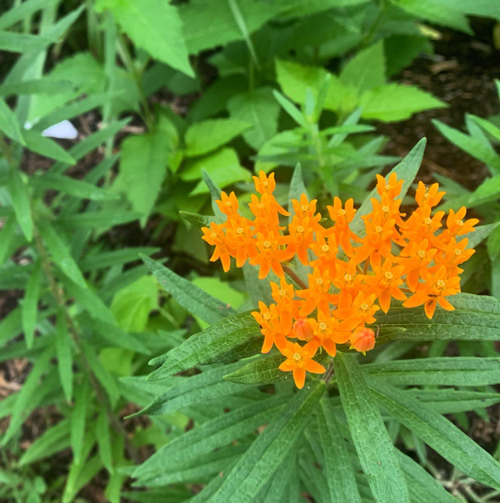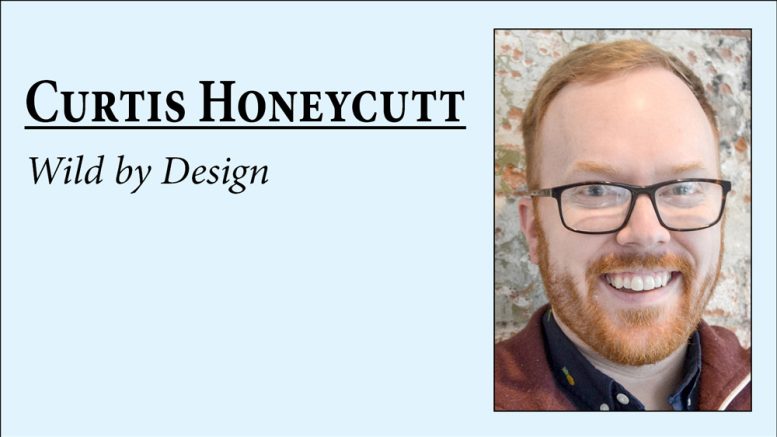A 2022 National Gardening Survey reported a significant rise in native plant purchases. Since 2019, the number of people buying them has nearly doubled, with 58 percent of surveyed consumers reporting purchases in 2022. Home gardeners are increasingly seeking out native plants at specialty stores and nurseries rather than traditional garden centers and big-box stores. So, what’s the deal with this floral phenomenon?
My journey down the native plant garden path started with monarch butterflies.
Around eight years ago, I read about how the eastern monarch population had declined by more than 80 percent since the 1990s. I learned that monarchs exclusively laid their eggs on milkweed plants. If I could do something to help in my own yard, I would.
That’s when I planted butterfly weed, an attractive member of the milkweed family featuring stunning orange flowers and deep green narrow-leaved foliage.
Once my butterfly weed bloomed, I noticed a stark contrast between this plant and others. Not only did the plant welcome monarch butterfly visitors, but I watched as multiple species of bees, moths and butterflies stopped by for a hit of the plant’s sweet nectar.
This didn’t happen with my other plants.

Photo provided by Curtis Honeycutt
I grew irises, hostas, daylilies, and daffodils in the flower beds around my house. These plants were attractive, but, after seeing the pollinator visitors to the butterfly weed, I observed that hardly any insects or birds interacted with the other plants. While pretty, the plants proved to be pretty boring to pollinators.
My family and I moved from our Fishers home into a house in downtown Noblesville the following year – not because of the plant situation, but because we loved the Noblesville house and its walkable proximity to local shops and restaurants. Although I was tempted to dig up the butterfly weed and bring it with us, I didn’t; the new owners deserved to witness the summertime array of cool butterflies for themselves.
As we settled into the new house, I decided to dig deeper into plants. I soon learned the difference between native and introduced plants. I discovered my yard could benefit bugs, birds, butterflies and other forms of biodiversity. The plants I inherited around my Noblesville house were a mix of natives, non-natives, and a few invasive species.
Gardening was fun, and I got to work editing the beds in my new yard. I yanked the invasives and began to plant native flowers from seeds and plugs. I realized I didn’t care for some of the introduced plants, but that I liked some of the others. To this day we still have non-native hydrangeas, peonies and tulips dotted around the mulched beds (not that there’s anything wrong with that).
Beyond attracting and supporting local pollinators, it turns out there are many benefits to planting native plants in your yard. Once established, most native plants require very little watering and need relatively little maintenance. They don’t need fertilizer or pesticides. Since they are acclimated to the area, native plants can withstand local weather conditions. By developing deep root systems, these plants actively provide erosion control and filter pollutants from reaching waterways. And many native plants are absolute showstoppers – the right plant in the right place can provide a ton of curb appeal in any suburban setting.
I’m not a native plant expert – I’m more of an enthusiast. Perhaps “plant nerd” is a more fitting term. In Wild by Design, I don’t plan to use many scientific names for plants, and I won’t flaunt any hoity-toity horticultural titles in front of you. I want you to take steps along with me to make our Hamilton County yards both beautiful and beneficial.
I want us to cultivate vibrant landscapes that celebrate the unique beauty and ecological benefits of native plants in Hamilton County. That doesn’t mean you have to go outside and immediately rip up all your flower beds; however, this column is intended to encourage readers to thoughtfully consider adding these plants to their outdoor habitats along the way. Thanks for going on this outdoor adventure with me.
Curtis Honeycutt is a Noblesville-based columnist and author. Send him your questions, comments and suggestions at curtis@curtishoneycutt.com.


Be the first to comment on "What’s so great about native plants?"